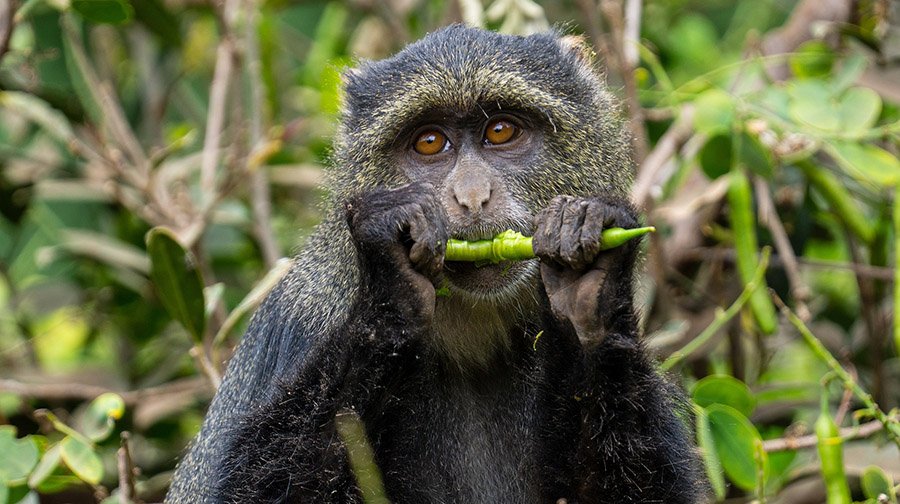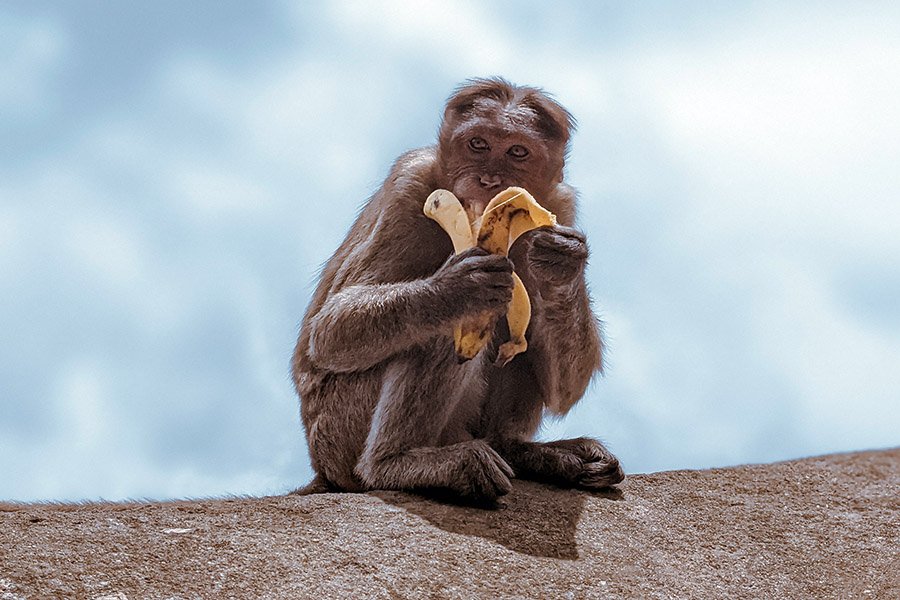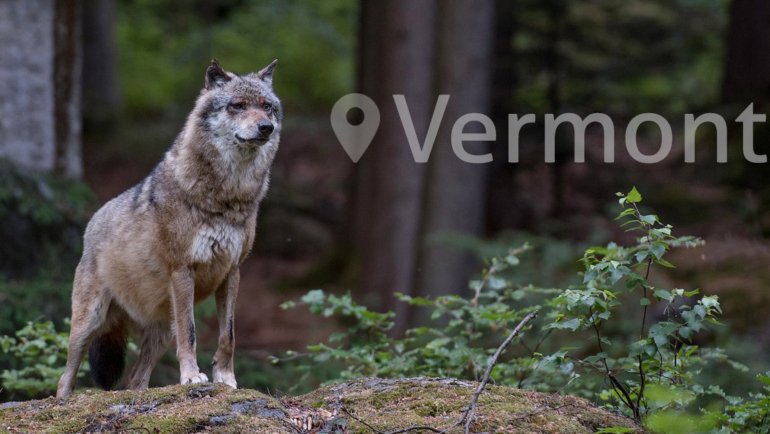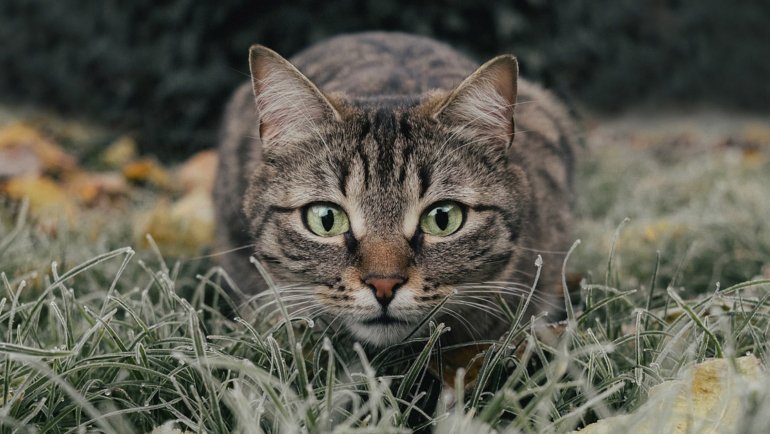One of the most common misconceptions associated with monkeys is that their favorite food is bananas. The mainstream media is to blame for this; since they have seriously promoted this notion in almost all shows/programs, stories, and even cartoons.
If you ask children (and even adults) an ideal food product to feed monkeys, there’s a high probability that bananas will be their first and maybe the only suggestion stated.
Therefore, reading this article to the end is essential as it will help you understand why I’m saying the monkey-banana concept is often exaggerated.
Do Monkeys Eat Bananas In The Wild?
Surprisingly, monkeys rarely (or never) eat bananas in the wild. The main reason is that banana plants don’t grow in the wild (at least, not the big bananas we all know). It’s a domestic plant cultivated by humans, meaning it does not grow in the jungle or wild ecosystems where most wild monkeys are present.
Therefore, only the primates living in areas close to human settlements encounter this fruit; when they invade farms with banana plants.
To simplify this concept, bananas to monkeys are like candy/sweets to humans. The same way you won’t find sweets or chocolate anywhere unless you buy it in a shop or somebody gives it to you is the same way wild monkeys don’t have access to bananas (unless they live close to humans and invade their banana plantations).
What Do Monkeys Eat in The Wild?
Those who previously thought bananas were the primates’ staple food may now wonder what monkeys eat in the wild.
It’s essential to note that all primates and apes (including monkeys) are omnivorous animals. It means that although they primarily feed on vegetation and fruits, they supplement their diet with flesh/meat.
Also read: Why Do Baboons Have Red Bottoms?

Monkeys in the wild feed on; leaves, soft barks and roots, fruits, insects, rodents, poultry/birds, fish, nuts, seeds, and eggs. Since these species occupy multiple and diverse ecosystems (and due to their high adaptability nature), they can consume any nutritional items available in their habitat.
For instance, baboons can kill and eat some of the most dangerous predators, like lion and leopard cubs, when an opportunity to hunt them arises. There is also evidence of monkeys feeding on other primate species when they kill them after invading their territory.
How Do Monkeys Peel And Eat Bananas?
Scientists, wild animal researchers, and wardens/caretakers that feed monkeys in captivity have observed and concluded that monkeys usually use these four ways to peel and eat bananas:
The “Normal”/Human Way
Due to their high IQ levels, monkeys have managed to copy our way of eating the fruit by peeling off the exterior skin from the protruded stem part (the edge that connects the banana to the parent plant) and sliding the peel downwards to the base of the fruit.
The Opposite/Inverse Tactic
Instead of starting from the banana’s front stem-end to the base, some monkeys start from the base heading to the front.
From The Middle
This tactic is usually used by monkeys seeing the fruit for the first time; they have never seen other primates or humans consume it.

Due to their curiosity and lack of patience, they bite the middle part of the banana and peel the exterior skin in any direction that seems fit or easier when peeling off the exterior fruit’s cover.
The ‘Squeeze, Pop and Extract’ Strategy
This method is common among inexperienced monkeys who find a banana and are clueless about peeling it. They make a small tear on any part of the fruit, squeeze it to pop the interior content, and eat it.
It doesn’t matter what end or part they start with; as long as the soft part of the banana is exposed, they press/squeeze it to reveal the entire fruit.
Do All Monkeys Peel Bananas?
No, not all monkeys peel bananas. It’s essential to note that most primates (especially those in captivity) have learned the peeling habit from humans and other monkeys.
Therefore, wild monkeys that encounter this fruit and have never seen humans or other primates taking off the exterior part of the fruit (the peels) will directly eat the whole banana without peeling it.
Also read: How Strong is an Orangutan? (Much More Than You Think!)
Do Monkeys Eat Banana Peels?
Yes, it’s common for monkeys (especially wild ones) to eat banana peels. As previously stated, if the primate has never seen their species members or humans peeling the fruit, they will eat the whole banana without removing the exterior part.
However, if the fruit supply is limited and the previous monkey peeled off the banana, the other monkey(s) will eat the remaining peels.
Since primates are omnivorous, it’s healthy for them to consume these parts as they contain high levels of potassium and fiber, essential in assisting their bodies to digest other foods consumed.
Why Do Monkeys Like Bananas?
The high sugar content present in the fruit makes it desirable. Therefore, the fruits’ sweet taste is the main reason monkeys like bananas. It’s the same reason why most humans (especially kids) like eating candy and chocolate.

Frequently Asked Questions
What Fruits Do Monkeys Eat?
Monkeys are highly adaptive and opportunistic feeders, meaning they can eat any available food (including fruits). Therefore, they are not choosy when it comes to their diet.
Apart from bananas, they can also eat mangoes, watermelons, grapes, passion fruits, strawberries, avocados, and any other fruit while in captivity.
Wild monkeys will also eat any fruits present in their natural habitats. Some of the most common ones include; wild berries and jack fruits, marula (mainly found in South Africa), dragon fruits, kei apples, and cherries.
Are Bananas Bad For Monkeys?
You’ll be surprised to learn that most animal nutritionists agree that bananas are bad for monkeys. It’s one of the main reasons why I stated earlier that the widely publicized notion concerning monkeys and bananas is a misconception.
According to nutritionists, the high sugar content in these fruits harms these primates. It may lead to tooth decay and also cause diabetes. Their digestive system is almost similar to humans; hence they are prone to the same high sugar-related complications that may affect us.
Over-ripe bananas cause stomach discomfort by altering their gastrointestinal acid/pH level since most banana plantations often use artificial fertilizers, which end up in the primates’ digestive system. These experts also concluded that excessive consumption of the fruit might cause obesity in the primate.
These are the major reasons why most zoos and animal orphanages with primates (monkeys, baboons, and chimpanzees) prohibit visitors from feeding these animals.
What Is The Correct Way To Peel A Banana?
According to Wikipedia, these are the best ways to peel a banana correctly.
The first and most common way is the normal method of starting from the stem and peeling downwards. The second one, inverse/upside-down/monkey magic, involves starting with the base and peeling the skin towards the stem.
The third one is breaking the fruit from the middle and peeling the sections from the exposed ends. You can also use a knife to cut through the fruits’ exterior surface and then use your hands to peel the skins.
Final Thoughts
As you’ve seen, monkeys enjoy eating bananas(and, at times, the peels), although it’s not their staple food as we have been programmed to believe by the mainstream media.
You also understand why most animal sanctuaries, where these primates are present, often discourage visitors from feeding them with bananas.




